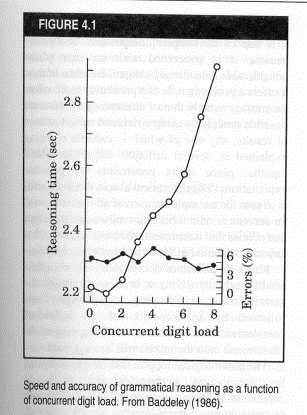
Information-Processing
Theories of Development
Psy 611
I. Overview
A. Recognizes 2 basic characteristics of human thinking (cognition)
1) limited in amount & speed
2) flexible, adaptable
B. Recognizes that both structure and processes make up the cognitive system

II. Structures
A. Sensory Memory
Memory based on a particular sensory modality
Briefest memory stores last for only a fraction of a second...An integral part of the process of perceiving
Iconic memory (for vision) and echoic memory (for audition) represent the earliest stages of sensory memory
Similar systems probably exist for the other senses
**What is the capacity and duration of iconic memory?
For lecture:

Sperling (1960)—whole-report technique—presented participants (Ps) with a stimulus comprising three rows of four letters. When shown these for 50 msec, followed by a blank white field, Ss were able to report only about four or five of the twelve letters.
Were these the only letters that had been seen, or could P have seen them all, but forgotten some of them in the time it takes to report five letters?
Partial-report technique—P cued to report only one line of letters

How should Sperling’s results be interpreted?
Sperling described iconic memory as precategorical
Once the item is scanned, need to rehearse or the information will be lost.
Auditory confusion errors--tendency for errors to be similar to the correct item in sound rather than in visual characteristics. Suggests speech-based coding of visually presented letters.
**What is the capacity and duration of echoic memory?
Partial report for echoic memory--Darwin, Turvey, and Crowder (1972)
Three lists of three digits. Played 3 lists simultaneously from 3 different locations.


Clear advantage for partial report up until approx. 4 seconds
Capacity is not as large as with iconic memory, but echoic memory lasts longer
Echoic memory
appeared similar to iconic memory with just two minor differences:
(1) echoic memory lasts longer (approx. 4s compared to approx. 1 s for
iconic), but
(2) does not preserve as much information (about 4 or 5 items compared
to 8 or 9 for iconic)
B. Working (short-term) Memory
Capacity of Short-Term Memory
George Miller (1956)—“The
magic number seven, plus or minus two
Two main findings:
(1) Ss are unable to identify a
set of items that vary along only one dimension if there are more than a few
items

(2) Chunking--Increase capacity of short-term memory by grouping individual units of information into meaningful units.
Duration of the Trace in Short-Term Memory
Brown-Peterson Paradigm
Purpose—determine rate at which information decays in STS

Results-- rapid rate of forgetting after as little as 18 s
Forgetting in short-term memory--decay or interference?

Important question--Is short-term memory (STM) only a temporary storage place or does it also have some processing capabilities?
Baddeley's (1986)
dual-task technique--Ss were required to remember number sequences ranging from zero
to eight digits in length, while at the same time performing a reasoning test.
Assumption:
Performing a concurrent STM task should lead to a dramatic impairment in
performance IF STM is a unitary system .
Effect of concurrent memory load on the speed and accuracy with which Ss
performed the syntactic reasoning test:

Results:
(1) reasoning time increases clearly and systematically with concurrent memory
load (2) The effect, however, is not catastrophic
If
STS is a unitary system, a concurrent load of eight digits should cause
reasoning performance to break down completely. It does not.
Earlier
concept of a unitary STS is challenged and replaced by a multi-component working
memory model.
The limits of digit span may be set by one of a number of subsystems, leaving
other components of working memory relatively unimpaired.
Baddeley proposed a model of working memory in which a controlling attentional
system supervises and coordinates a number of subsidiary slave systems.
Three
components—(1) central executive, (2) phonological loop, and
(3) visuo-spatial sketchpad

C. Long-Term Memory
III. Processes
Cognitive processes vary in how much attention they require
Controlled (effortful) processes--require a great deal of attention
Automatic processes--require very little, if any, attention
Amount of attention required is influenced by type of information being processed and by amount of experience person has with that type of material
For types of info. that initially require a great deal of attention, practice can reduce amount of attention required
Automatic processing is important in development because it provides a ready-made route for learning about the world...e.g, retaining frequency information
Other processes, however, may change from controlled to automatic as experienced is gained with that type of information...e.g., single-digit addition
B. Encoding
Internally representing information
However, not all information about the world can be encoded...just too complex
Children must learn to encode important features of objects and events in order to later benefit from the information...must learn to do so efficiently